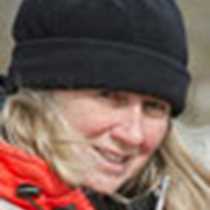Le Conte Bay and Petersburg
Although summer is marching towards closure, the sun still rises early, and every morning holds promises of new adventures and sights to see. Today clouds hugged the mountaintops and hid in the valleys amongst the trees. Raindrops on the calm waters looked like dancing insects, each creating individual patterns of concentric waves. Close to the shoreline pale turquoise jewels glimmered as if illuminated by an internal light. Escapees from the corralling terminal moraine of a hidden glacier, they were riding the falling tide north in Frederick Sound. Mile by mile their numbers increased until their density was so great we felt we had to join them.
Bundled warmly within water impermeable layers we set out in Zodiacs to visit this gallery of glassy ice, children of Le Conte Glacier. Hundreds of shapes and forms surrounded us. Stranded on shore or wedged in the floor of the bay, the largest stood fast waiting for the tide to return and set them on their way. Many wait for days or weeks before their roots erode or before the phases of the moon work hand in hand with the spinning of the earth to bring back higher floods to release them once again. Growlers or smaller fragments of ice drifted here and there. Less impressive visually, they won in auditory appeal with a crackling rendition of rice krispies dropped in milk. But it was the bergs and bergy-bits that really stole the show. They were blue, gelid blue with pewter stripes, azure or cerulean. The colors were fugacious and indescribable. We wondered if any artist anywhere could capture the grandeur of the scene.
Petersburg’s harbor bustled with the daily activity of an Alaska fishing town. Tenders pulled up to the cannery piers disgorging their loads of salmon. Inside hands worked rapidly to clean and fillet each fish or collect and sort the roe. Elsewhere crab pots were loaded onto a waiting vessel while another crew carefully wound a gill-net onto a drum. Purse-seiners waited patiently in the marina, their dories perched high on their sterns waiting for their turn at a salmon opening.
Across Wrangell Narrows a trail led into the woods. Dark and foreboding, second growth forest gave way to brilliant shades of green where fallen trees let light seep through. Ferns and mosses, shrubs and flowers filled in the void. The scent of cedar reached our nostrils signaling another change. The trees thinned. Spruce and hemlock gave way to stunted pines. Sphagnum hummocks pocked the land and channeled rivulets flowed into tannic pools. Water striders dimpled the water’s skin, rowing frantically and erratically from edge to edge. Carnivorous sundews glistened, inviting unwary prey to sample supposed nectar drops from red and glowing hairs. Fooled, tiny gnats or other insects stick fast to folding leaves that unceremoniously devour them and cast their exoskeletons away. Drowned in water but living in drought, these plants of bog and fen demonstrate remarkable techniques of survival with minimal means.
We, on the other hand, wallowed in plenty, consuming copious quantities of fresh Dungeness crab as we sailed from the dock, heading north.




